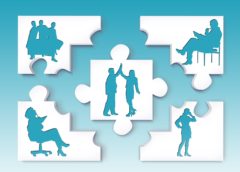One of the great challenges of Electronic Medical Records adoption is bridging the divide between clinic-speak and IT-speak. For those of us who have worked on both sides of the divide, it is easy to see that even experience cannot reconcile the abundance of information in healthcare and in information technology. What can help is maintaining a level of patience and respect needed to address the common needs of both industries.
Healthcare professionals, are you tired of feeling like IT professionals ignore your needs? Does your IT staff appear to adopt an attitude and treat you as if you know nothing when you are stuck on an IT issue? Information Technology professionals, do you find yourself brushed off by healthcare staff, when they call for assistance? Have you ever had the experience of building a piece of software to a user’s requirements that was then rejected due to miscommunication during the project?
Having left the field of direct patient care and transitioned to the Information Technology field, I have found that it does not benefit either side to assume our compatriots have anything but good intentions. Both IT and healthcare professionals can find a productive way to approach the common goals of accurate records and excellent patient care through collaboration, meeting etiquette, respect, and communication. Whether we are focused on a large-scale project, a customized feature, or a bug in the system, demonstrating basic courtesy in meetings builds goodwill in any team effort and makes the most of the time spent in those meetings.
Prepare in Advance for the Meeting
Healthcare professionals should prepare by:
- Gathering the opinions and needs of coworkers their specific department.
- Getting clearance from boards or committees.
- Providing concrete examples.
- Clearly communicating these needs as close to “step-by-step” instructions as possible.
IT professionals should prepare by:
- Researching healthcare forms and requirements.
- Providing visual examples instead of descriptive examples when possible.
- Providing an assessment and timeline for project prioritization and completion.
- If current projects and expertise required for the project will increase the time to completion, then prepare an estimate of the time and hindrances that may affect completion.
Showing up on Time
Timeliness is a common courtesy. We are all busy with full days, and none of us wants to be in the position of waiting for someone else. Demonstrating respect for another’s time goes a long way toward building trust and understanding on a project. Pick a time and write it on your calendar to avoid repeatedly rescheduling meetings and being late.
Avoid or Translate Technical Terms or Acronyms
Both the healthcare and IT industry have a plethora of acronyms and technical terms, many of which overlap. An example would be the acronym ACL which is ‘access control list’ in the IT world and ‘anterior cruciate ligament’ in the healthcare world. Clear communication dictates that we avoid the use of acronyms or clearly define them when acronyms are used.
Provide Your Full Attention
Another common courtesy is to focus on the presenter or discussion at hand. Checking your cell phone or other devices is distracting for you and the people with whom you are working. If you are waiting on a call or are on a call, please alert individuals in the meeting and leave the room to take any calls. While all of us have experienced the feeling that meetings distract from our “real” jobs, we all need to understand that meetings are critical to our success. The better we prepare, attend, and pay attention the greater our success will be.
Respect Competence and Initiative
Both IT and healthcare professionals should be treated with respect and appreciated for their commitment to attending meetings and answering questions. Both industries require dedication and competence to successfully perform job functions as well to develop solutions to project issues. The project may be frustrating and taking longer than you would wish, but as long as the commitment to attending meetings and making progress remains, avoid taking out frustrations on those working with you and doubting their competence.
Know the Basics
Understanding the basics of both Healthcare and IT assists tremendously with accurate and efficient communication when working as a team. IT professionals need to research and understand the needs and requirements that Healthcare professionals must meet. Most data that Healthcare professionals use focuses on efficient patient care, accuracy, and measuring that accuracy for oversite and compliance. Whenever possible gather examples of forms, research the necessary requirements for patient care, and ask the Healthcare professional for clarification of terms or requirements.
In turn, healthcare professionals must also understand the basics of their facility’s IT system, being sure to take advantage of training offered by their facility and/or the IT department so that there is a basic working knowledge of the hardware and software that healthcare professionals are using. It is also helpful to write down steps taken when tech support is required. Tech support staff often start with basic techniques that are useful in many situations, not just in the workplace.
The challenge of the communication divide can be successfully traversed through the use of proper communication skills. Taking steps to remember basic etiquette and preparation can increase the success of projects and future collaboration. Many hurdles to project completion can find resolution through a commitment to communication, clarity, research, and attention.
